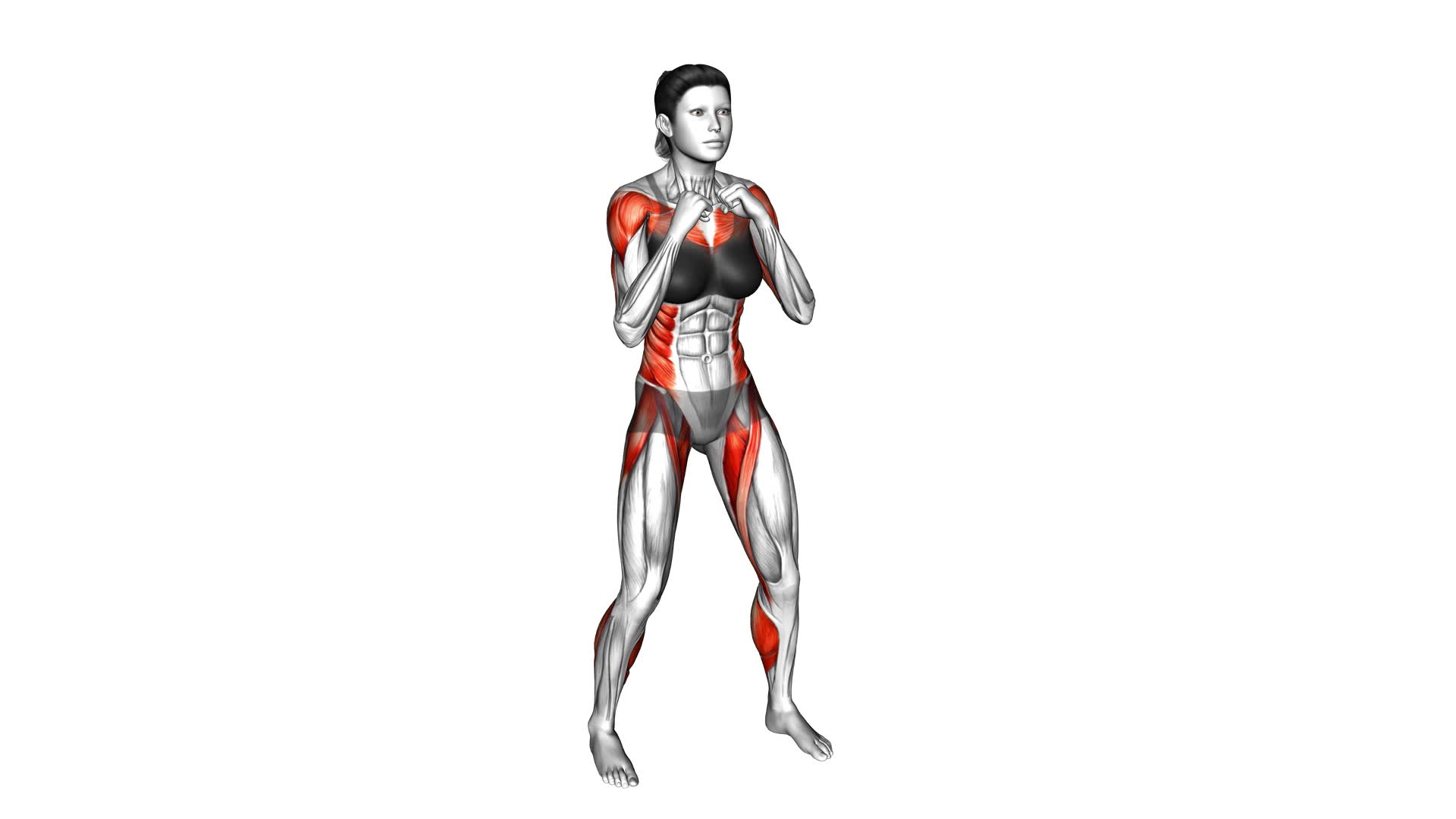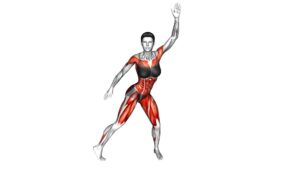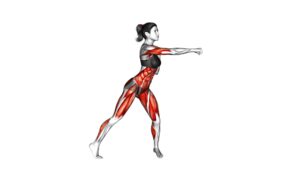Diagonal Punch (female) – Video Exercise Guide & Tips

Get ready to punch your way to a stronger, more toned physique with the Diagonal Punch! This quick and effective exercise targets your core, arms, and shoulders.
Watch This Exercise Video
In this video exercise guide, you'll learn the proper form and technique to maximize your results. Whether you're a beginner or looking for a challenge, we've got modifications and advanced variations for you.
Say goodbye to common mistakes and hello to a killer workout routine that will leave you feeling empowered and accomplished.
Let's get punching!
Key Takeaways
- The diagonal punch targets the core, arms, and shoulders, while also building strength and endurance.
- Proper form and technique are important for maximizing the benefits of the exercise, including maintaining control, keeping the back straight, and positioning the fists at chin level with elbows bent.
- Alignment and positioning are crucial for the exercise, with feet hip-width apart, knees slightly bent, and the spine aligned and back straight.
- Muscle engagement and control should be emphasized, with a focus on engaging the core, activating the shoulder muscles, and maintaining control to enhance effectiveness and reduce the risk of injury.
Benefits of the Diagonal Punch
To maximize your workout and target multiple muscle groups, the diagonal punch exercise allows you to engage your core and upper body simultaneously. This exercise is highly beneficial as it not only helps you build strength and endurance but also improves your overall coordination and balance.
Before diving into the diagonal punch exercise, it's important to warm up your muscles properly. Warming up prepares your body for the intense workout ahead, increasing blood flow and flexibility while reducing the risk of injury. Start with some light cardio exercises like jogging or jumping jacks, followed by dynamic stretches that target the muscles you'll be using during the diagonal punch.
One of the great things about the diagonal punch exercise is that it can be modified to suit different fitness levels. If you're a beginner, start with lightweights or no weights at all, focusing on mastering the technique and maintaining proper form. As you progress, gradually increase the weight or resistance to add more challenge and intensity to your workout.
Proper Form and Technique
To perform the diagonal punch with proper form and technique, it's important to focus on alignment and positioning.
Make sure your feet are shoulder-width apart, your core is engaged, and your back is straight.
Additionally, pay attention to muscle engagement and control. Activate your core and upper body muscles, and maintain control throughout the movement to maximize the effectiveness of the exercise.
Alignment and Positioning
Ensure that your alignment and positioning are correct to maintain proper form and technique while performing the diagonal punch exercise. To help you achieve this, here are some key tips:
- Stand with your feet hip-width apart to maintain a stable base.
- Keep your knees slightly bent to engage your leg muscles and provide support.
- Align your spine by keeping your back straight and shoulders relaxed.
- Position your fists at chin level with your elbows bent, ready to deliver the punch.
- Engage your core by pulling your belly button towards your spine.
By following these guidelines, you'll maximize the effectiveness of the diagonal punch exercise and reduce the risk of injury.
Now that you have established proper alignment and positioning, let's move on to the next section and delve into muscle engagement and control.
Muscle Engagement and Control
You need to engage and control your muscles properly to maintain proper form and technique while performing the diagonal punch exercise. Muscle activation, coordination, and stability are key factors in executing this movement effectively.
Engage your core muscles by drawing your belly button in towards your spine and keeping your back straight. This will provide a stable base for the movement.
Activate your shoulder muscles as you extend your arm diagonally across your body, focusing on the contraction and control of the muscles.
Maintain control throughout the exercise, avoiding any sudden or jerky movements. By mastering muscle engagement and control, you'll enhance the effectiveness of the diagonal punch exercise and reduce the risk of injury.
Now, let's move on to modifications for beginners.
Modifications for Beginners
If you're new to the diagonal punch exercise, don't worry! There are simplified variations that can help you ease into it.
By starting with modified versions, you can gradually build strength and confidence.
Gentle progression techniques will allow you to improve over time without overwhelming your body.
Simplified Exercise Variations
When starting out with the Diagonal Punch exercise, it may be helpful to modify the movement to make it more accessible for beginners. Here are some exercise modifications that can still provide an effective core workout:
- Start with a lighter weight or no weight at all to reduce the intensity.
- Perform the exercise at a slower pace to focus on proper form and control.
- Decrease the range of motion by punching at a diagonal angle that feels comfortable for you.
- Keep your feet planted on the ground instead of adding a rotational movement.
- Use a resistance band or cable machine to provide assistance and support.
By incorporating these modifications, you can gradually build strength and confidence while still reaping the benefits of the Diagonal Punch exercise.
Gentle Progression Techniques
To gently progress and modify the Diagonal Punch exercise for beginners, incorporate these techniques.
Start by focusing on proper form and technique, ensuring that your body is aligned and your movements are controlled.
Begin with a lighter resistance or weight, gradually increasing as your strength improves.
Another strategy is to reduce the range of motion initially, gradually increasing the range as you become more comfortable.
Additionally, you can perform the exercise at a slower pace, allowing for better control and muscle engagement.
Remember to listen to your body and make adjustments as needed.
The key is to progress gradually, allowing your body to adapt and avoid overexertion.
With these gentle progression strategies, you can gradually advance and build strength with the Diagonal Punch exercise.
Advanced Variations and Progressions
As you progress in your training, incorporating advanced variations and progressions of the diagonal punch exercise will challenge and further strengthen your upper body and core muscles. Here are some advanced modifications and training techniques to take your workout to the next level:
- Explosive Diagonal Punches: Add power and speed to your punches by performing them explosively, focusing on quick and forceful movements.
- Weighted Diagonal Punches: Hold dumbbells or wear weighted gloves to increase resistance and intensify the exercise.
- Plyometric Diagonal Punches: Incorporate jump movements into your punches, such as jumping lunges or squat jumps, to enhance both strength and cardiovascular fitness.
- One-Legged Diagonal Punches: Challenge your balance and stability by performing the exercise while standing on one leg. This variation engages your core and leg muscles even more.
- Medicine Ball Diagonal Punches: Use a medicine ball to add an extra challenge. Hold the ball in your hands while performing the punches, adding resistance and requiring more control.
Remember to always maintain proper form and technique, and gradually increase the difficulty as you become more comfortable with these advanced variations. Push yourself to reach new limits and achieve even greater results.
Keep challenging yourself, and your body will continue to grow stronger.
Common Mistakes to Avoid
To avoid common mistakes while performing the diagonal punch exercise, you need to be mindful of your form and technique. One common mistake is using excessive force and sacrificing proper technique. Remember, the power in this exercise comes from the rotation of your core and the engagement of your muscles, not from forcefully throwing your arm.
Another mistake is neglecting proper alignment. Make sure to keep your feet shoulder-width apart, knees slightly bent, and your core engaged throughout the exercise. It's also important to avoid rounding your shoulders or leaning forward as this can put unnecessary strain on your upper body.
Another common mistake to avoid is forgetting to breathe. Remember to exhale as you punch and inhale as you return to the starting position. Proper breathing helps to oxygenate your muscles and improve your overall performance.
Lastly, be mindful of your hand position. Keep your wrists straight and your fingers relaxed. Avoid clenching your fists too tightly, as this can lead to tension in your muscles.
Incorporating the Diagonal Punch Into Your Workout Routine
To incorporate the diagonal punch into your workout routine, focus on gradually increasing the intensity and incorporating variations of the exercise to challenge your muscles and continue progressing. Here are some workout tips to help you make the most out of this exercise and optimize your fitness routine:
- Start by mastering the basic form of the diagonal punch. Ensure that your feet are shoulder-width apart, engage your core, and maintain proper alignment throughout the movement.
- Increase the intensity by adding resistance. You can use dumbbells or resistance bands to provide added resistance and make the exercise more challenging.
- Incorporate variations of the diagonal punch to target different muscle groups. For example, you can try performing the exercise on an unstable surface like a balance board or using a medicine ball for added core engagement.
- Include the diagonal punch in a circuit or interval training workout. This will help to keep your heart rate up and maximize calorie burn.
- Track your progress and gradually increase the number of reps or sets as you get stronger. This will help to ensure continuous improvement in your fitness routine.
Frequently Asked Questions
How Many Calories Does the Diagonal Punch Exercise Burn?
The diagonal punch exercise is a great way to burn calories and promote weight loss. By incorporating dynamic movements and engaging multiple muscle groups, this exercise can help you achieve your fitness goals.
It's important to remember that the number of calories burned during any exercise can vary depending on factors such as your weight, intensity level, and duration of the workout. However, by regularly incorporating the diagonal punch into your routine, you can maximize calorie burn and work towards your weight loss goals.
Can the Diagonal Punch Help With Weight Loss?
The diagonal punch is an effective exercise for toning your muscles. It engages your core, arms, and shoulders, giving them a good workout.
Incorporating the diagonal punch into your cardio routine can help with weight loss by increasing the intensity of your workout and burning more calories.
It adds variety to your routine, making it more enjoyable and motivating.
Is the Diagonal Punch Suitable for People With Joint Problems?
If you have joint problems, it's important to find exercises that are suitable for you. The diagonal punch may not be the best option for you, as it can put strain on your joints. However, there are joint-friendly modifications you can make to the exercise or alternative exercises you can try.
It's crucial to listen to your body and consult with a professional to find the best exercises that won't exacerbate your joint issues.
How Long Should I Perform the Diagonal Punch Exercise to See Results?
To see results from the diagonal punch exercise, you should perform it consistently and with proper form. Aim to do the diagonal punch exercise for at least 15-20 minutes a day, or incorporate it into your regular workout routine. Remember to engage your core, keep proper alignment, and maintain a controlled and powerful punch for maximum effectiveness.
The benefits of this exercise include improved upper body strength, increased stability, and enhanced cardiovascular endurance. Stay motivated and enjoy the progress!
Can the Diagonal Punch Be Done Without Any Equipment?
To answer your question, yes, the diagonal punch can be done without any equipment. It's a versatile exercise that targets your core, arms, and shoulders.
If you're looking for alternative exercises, you can try shadow boxing or resistance band punches.
The diagonal punch offers numerous benefits like improved upper body strength, coordination, and stability.
So, feel free to incorporate this exercise into your routine and enjoy the results!
Keep pushing yourself and never give up!
Conclusion
The diagonal punch is a powerful exercise that targets multiple muscle groups, improves coordination, and enhances overall fitness. By maintaining proper form and technique, beginners can gradually increase intensity and challenge themselves with advanced variations.
Avoid common mistakes such as using too much momentum or neglecting proper alignment. Incorporate the diagonal punch into your workout routine for a dynamic and effective full-body workout.
Stay focused and committed, and watch your strength and confidence soar. Keep pushing, and you'll reach your fitness goals in no time.

Author
Years ago, the spark of my life’s passion ignited in my mind the moment I stepped into the local gym for the first time. The inaugural bead of perspiration, the initial endeavor, the very first surge of endorphins, and a sense of pride that washed over me post-workout marked the beginning of my deep-seated interest in strength sports, fitness, and sports nutrition. This very curiosity blossomed rapidly into a profound fascination, propelling me to earn a Master’s degree in Physical Education from the Academy of Physical Education in Krakow, followed by a Sports Manager diploma from the Jagiellonian University. My journey of growth led me to gain more specialized qualifications, such as being a certified personal trainer with a focus on sports dietetics, a lifeguard, and an instructor for wellness and corrective gymnastics. Theoretical knowledge paired seamlessly with practical experience, reinforcing my belief that the transformation of individuals under my guidance was also a reflection of my personal growth. This belief holds true even today. Each day, I strive to push the boundaries and explore new realms. These realms gently elevate me to greater heights. The unique combination of passion for my field and the continuous quest for growth fuels my drive to break new ground.



